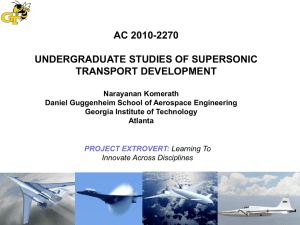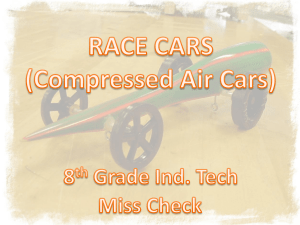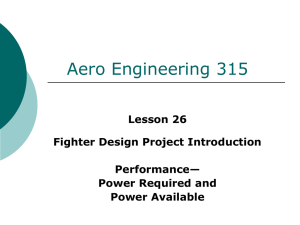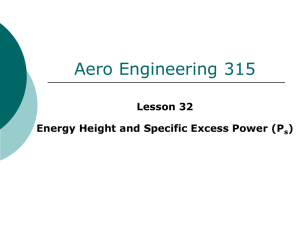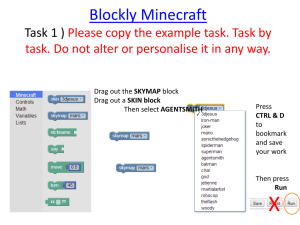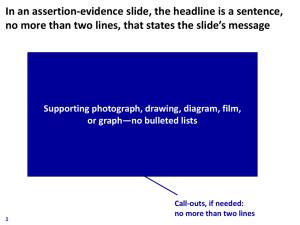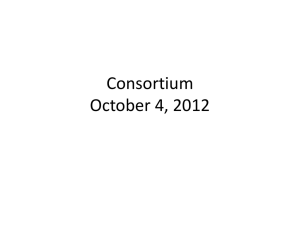ASEE11_SST_Komerath - Georgia Institute of Technology
advertisement
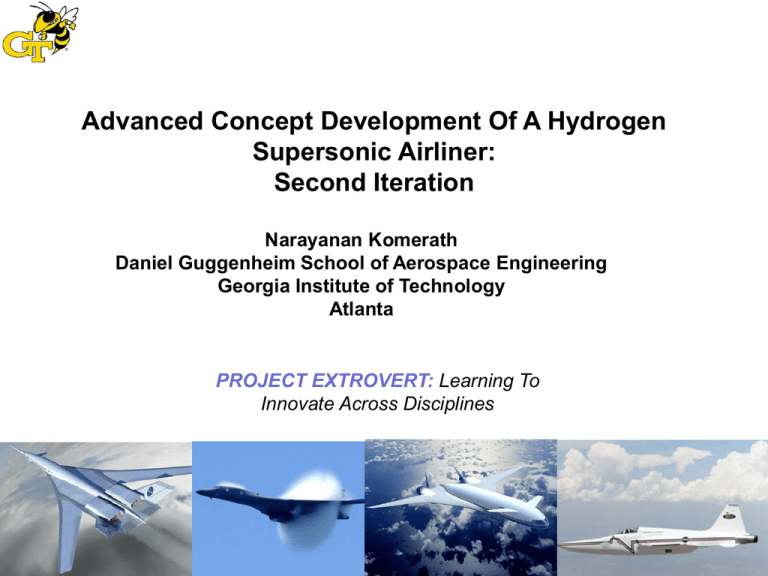
Advanced Concept Development Of A Hydrogen Supersonic Airliner: Second Iteration Narayanan Komerath Daniel Guggenheim School of Aerospace Engineering Georgia Institute of Technology Atlanta PROJECT EXTROVERT: Learning To Innovate Across Disciplines Summary • • Advances in curriculum to enable development of advanced concepts. 2010: 3 levels of undergraduate experiences in taking a new look at the prospect for supersonic flight. Including demographics, economics, environmental business case, and supersonic aerodynamics: - freshman introduction to conceptual design and making a business case for hydrogen with carbon market predictions - junior/senior Sears Haack Minimum Wave Drag body calculations for supersonic hydrogen airliner - team Special Problem leading to a peer-reviewed conference paper New 2011: -Concept exploration results from last year are the starting point for this year’s course assignments. The gaps in learning seen last year are being addressed this year. - Developing a peer-reviewed paper - Presenting to industry experts - Junior Senior high speed aero class asked to start with conceptual design and technical paper, and use supersonic area ruling to improve the prediction (not the design, just the certainty of the prediction). - AIAA paper on integrating a simple CAD code with MatLab and classical supersonic aerodynamics to improve efficiency of conceptual design process and enable radical innovations. - Experience of bringing “hard” problems back into senior courses, with state-of-the-art technical capabilities. Project Structure for EXTROVERT: Learning To Innovate Across Disciplines. UR Here Test case: Can we actually use these resources to advance undergraduate learning? Concept Development Exercise Exercise in challenging “conventional wisdom” and taking a fresh look at a global challenge problem. Aim: Make supersonic airline travel viable for the mass market. Approach: •Conceptual design at several levels, combining technical knowledge with global demographics, economics, sustainability and public policy issues. •Validate calculations by confirming present day conclusions, then challenge assumptions and show alternative path to viability. •Go from requirements definition to “ticket price per seat mile” •Refine technical design and economics AE3021 High Speed Aerodynamics Final 3-hour core course in aerodynamics/fluid dynamics/gas dynamics, following 3 hours of AE2020, Low Speed Aerodynamics, and 4 hours of AE3450, Thermodynamics and Gas Dynamics. Compressible potential flow for subsonic and supersonic aerodynamics. Shock/expansion analyses, compressible boundary layer calculations. Major Assignment (teams of 2): Select an airplane configuration and analyze one subsonic and one supersonic design point, calculating lift to drag ratio without resort to CFD. Used Sears-Haack body and compressible boundary layers to estimate minimum drag for supersonic aircraft. Problem Formulation: Predicting the drag of an LH2 SST Wave drag coefficient becomes very high because of the volume of LH2. Need a good way to estimate wave drag of a configuration at Mach 1.4. Objectives: 1. Refine minimum-drag body shape and drag value for the supersonic area rule rather than the transonic (cross sections) area rule. 2. Devise an efficient technique to couple the supersonic area rule method with an engineering drafting tool such as CATIA or AutoCAD, or simpler versions. Crucial to enable iterative geometry changes, and do the supersonic wave drag computation. 3. Estimate the compressible boundary layer drag over the final configuration at the design supersonic and subsonic Mach numbers, and thus refine the conceptual design numbers. Final Assignment of course, 6 weeks, weekly reporting in stages • Form teams of two each (or work alone for no extra credit or consideration) • Start with published conference version of paper by the Special Problem Team and 1-hour presentation • Copies of several reports papers, links to supersonic aircraft designs done by student teams in NASA competitions. • Web-based notes, examples. Assignment Steps • • • • • • • Week 1: Start report, analyze problem & conceptual design spreadsheet, develop approach to design an aircraft configuration including space for the passengers and cargo, fuel, engines, intake and exhausts, wings and tails. Week 2: Develop & compare cross-section area distribution with Sears-Haack distribution for same total volume and length constraints. Find Sears-Haack drag, and percentage error in area distribution compared to Sears-Haack. Week 3: Use linear theory to estimate drag and compare with Sears-Haack expression. See if second order theory for pressure coefficients does better. Explain the differences. Week 4: Examine supersonic wave drag calculation in several papers, and explore ways to implement it efficiently using a CAD software package. Week 5: Implement supersonic wave drag computation by taking intercepted area in Mach cones rather than oblique planes. Link the Mach cone procedure to CAD package and use it to iterate projected area distribution towards ideal Sears-Haack. Week 6: Calculate compressible boundary layer skin friction drag for final configuration using the Boeing high Reynolds number reference temperature method modified from the Schulz – Grunow method, for the Mach 1.4 cruise condition and a subsonic cruise condition. Finals Week: Submit the final report with the initial and improved conceptual design comparison, and the refined seat-mile cost estimates. Student performance Start : Unique and extreme disdain of “derivations”. Many disasters in the first 3 tests. • Very large spread of performance from superlative to negative points. • Post-Drop Day class vastly different. Many questions about prospects for supersonic flight. • Final reports: even the students who did not pay much attention to the assignment, actually did some exploration and rationalization regarding hydrogen-fueled supersonic airliners. • The best assignments reflected superlative independent thinking and exploration. Sought and found and read the classical papers on the subject to a good level of comprehension. • Sears-Haack body shape easily calculated, but linear theory produced wide spectrum of results. • Mostly due to arithmetic or logic errors; varying values of reference area and the length in calculating drag coefficients. • Compressible boundary layer drag calculations also produced spectrum of answers. • Layouts were typically revised 4 or 5 times until the designers decided that they could not get any closer to the Sears-Haack ideal. Often this was still quite far from the Sears-Haack and yielded drag as much as 30 to 50% higher. • One finely-formatted report was a regurgitation of unsupported statements from various “System Design” papers that declared the value of subsonic design optimization, nothing to do with the stated assignment. • Another team simply quoted statements from some reference to the effect that hydrogen fueled airliners were far off in the future, with no evidence of any serious calculations. Reminescent of AIAA journal reviewers. Student’s Problem Statement Examples General shape of the Sears-Haack body, and final configuration. From Durbin and Swits [Ref. 3]. Iterating the cross-section area with components included. From Dessanti and Ingraham [5] Configuration before and after supersonic area ruling. Discussion • • • • • • Initial shock: “modern curriculum” seems to be letting engineering students reach final year with no appreciation for either scientific logic or a sense of numbers ????? Concept Development exercise is demanding. It does bring out the best in many students: long list of references, innovation Supersonic area ruling is difficult, as evidenced by continuing publications in AIAA conferences of funded project results seeking to improve the iterative procedure. Top 50 percent of these assignments are impressive in enthusiasm, initiative and sustained effort . Conscious decision to not let the top students be dragged down by those on “cruise control”. No grading miracle: Wide disparity in performance made grade decisions quantitatively easy, emotionally difficult. Conclusions and Future Directions •Completes second iteration of the concept development process. •Started as a question on demographics and carbon market issues. •First iteration showed viability with top-level conceptual design in 2009-2010. •Second iteration refined aerodynamics, students added knowledge on various issues -usability and cost projections for liquid hydrogen. •-sonic boom alleviation technology, detailed configuration aerodynamics, internal layout issues. •Variety of procedures to couple CAD software with supersonic area ruling theory. •Large dynamic range in skills, capabilities and thinking experience of seniors. •Identified areas for substantial pre-graduation improvement in several students (up to half the class in this case), •Also showed impressive capabilities of the class overall. •Several innovations and the large amount of knowledge captured from the course •Sets the stage for professional level advancements in the area of supersonic aircraft development and aerodynamic design. Next step: •Refine sonic boom issues and alleviation techniques at the graduate course level Return to future iterations where drastically different configurations can be investigated. •Tough problems remain in all aspects, but this is not surprising. •Such an exercise removes the superficial appearances and cuts into the issues enough to reveal and address these problems. Acknowledgments • Development of this paper was supported by NASA under the EXTROVERT cross-disciplinary problem solving initiative. The technical monitor is Tony Springer, NASA HQ. Organization of this presentation •Introduction to the project •5 different levels at which concept development has been pursued. -AE1350 Freshman Introduction to Aerospace Engineering -AE3021 High Speed Aerodynamics -AE2xxx Special Problems -AE4xxx Special Problems - Undergraduate thesis •Technical issues & results •Observations regarding evolution of student experience •Conclusions •Acknowledgements Conceptual Design at Freshman Level • For given specifications, estimate payload using common sense (e.g., “What is the average weight of a passenger on an airliner? How much food and water should be carried per passenger?”) • From benchmarking guess Payload Fraction. Find Take-Off Gross Weight. • Wing Loading from benchmarking, find planform area. Fix span, find Aspect Ratio. • For selected cruise altitude and speed, find CL and CDi. • Guess low speed CD0. Find cruise L/D and Speed for Minimum Drag. • Use thumb-rules to select a suitable engine and number of engines. • For the selected engine, find thrust-specific fuel consumption from published data, and estimate thrust at altitude. • For specified range, find the fuel weight fraction needed at takeoff. • Given engine thrust-to-weight ratio, see if structure weight fraction is enough to build the aircraft. • Once the cruise point design is shown to close, find the steady flight envelope, against aerodynamic stall, thrust available, and maximum climb rate. •Find takeoff and landing distances. Implemented on spreadsheet for iteration, integration and plotting. AE 2xxx and 4xxx Special Problems 2 sophomores (alumni of AE1350, Spring 2010) and 3 seniors (all following completion of Aircraft Design capstone design course, 2 after AE3021 as well) signed up for 3-hour Special Problems, across 2 semesters. 1 other student signed up for an Undergraduate Thesis project. Summary of Issues Questions for consideration by undergraduates: • Drag implication of using hydrogen, given lower fuel weight fraction • Effect of post-1990 demographics and economics on market projections • Viable destinations, flight times, curfew and business implications • Impact of Global Warming/ Carbon emission reduction initiatives • Noise implications of hydrogen-powered SST? • Radical concepts to take advantage of the different features of hydrogen fuel, supersonic flight, and airport logistics AE1350 Freshman Introduction to Aerospace Engineering 2 hour freshman course, taught in Spring 2010. Several prior teachings since 1997, using Conceptual Design as the gateway to aerospace engineering. • • • • • • • • • • Designing a Flight Vehicle: Road Map Force Balance During Flight Earth's Atmosphere Aerodynamics Propulsion Performance Stability and control Structures and Materials High Speed Flight Space Flight Major assignment, done in teams of two: Conceptual design of a short-haul (~1000 mile range) subsonic airliner to carry 150 passengers. Spreadsheet calculation procedure, with range and structure fraction used as metrics of viability. Revise to incorporate liquid hydrogen fuel. Compare performance of the two versions. Calculate lifecycle carbon savings at today’s Carbon Market prices. Technical issues & results Issue #1: Lack of market. No incentive to build SST, because the passengers would be the same ones who now pay for first/business class tickets that make transonic airline routes profitable. Response: Post-1990 changes in air routes, global demographics and economics. Issue #2: SST not viable in 1960s, certainly not viable today with high fuel prices. Response: True for hydrocarbon-fueled SST. Not viable at all. Issue #3: LH2 requires large volume causing unacceptable supersonic body drag. Response: Not true. Large improvement in payload fraction due to high heating value of H2 means that the airplane is much lighter, and hence drag is not higher. Issue #4: Mach 2.5+ flight requires advanced materials. M<1.7 is inefficient. Response: M>1.4 not needed for mass market. Overall architecture is efficient at 1.4 Sears-Haack transonic drag estimate provides upper bound for ideal drag. OBSERVATIONS REGARDING EVOLUTION OF STUDENT EXPERIENCE 1. 2. 3. 4. 5. • • Conceptual Design Procedure: Freshmen comfortable and pick up quickly. Project Document for the conceptual design project to counter “last-minutitis”. Cross-disciplinary exploration comes easily for freshmen, harder for seniors! Basic knowledge issues persist with seniors and graduate students. Implementation Experience: Undergraduate thesis student decided that taking courses was easier. Taking advanced courses confuses students! Only a few build the trait of thinking about the methods that they learn. • Students from AE3021 and Capstone Design reluctant to use simple conceptual design process given in AE1350. Eventually realized that their complex formulae gave the same results when used correctly. • When faced with unacceptable numbers, hesitant to do anything about it! (L/D <3 – but “only in cruise”!) AIAA Student Conference paper withdrawn. • Poster prepared and discussed with better results. • Paper to peer-reviewed conference done successfully. 6. Vertical Integration aspects: After enough iterations, and given examples, students do pick up and do an excellent job. SUMMARY OF OBSERVATIONS Overall design calculations Market / demographics issues Applying “theory” learned in classes Capturing essence of design approach Using math to develop bounds CONCLUSIONS 1. Multilevel process to explore a high-risk concept using undergraduate participants. 2. Vertical and horizontal knowledge integration aspects explored, with differing levels of success and difficulty. 3. Simple conceptual design procedure permits students to explore advanced aircraft concepts and see what is needed to make the design close. 4. Process then used as starting point for detailed configuration analysis. 5. Conclusions on the LH2 SST: • Huge change in Eastern Hemisphere demographics, politics and economics • Large rise in engine T/W and drop in TSFC since Concorde days • Fossil-fuelled SST is still not viable at today’s fuel prices • LH2 drag penalty is absent, due to large gain in payload fraction. • LH2 becomes more attractive as fossil costs rise and H2 costs decrease. • LH2 SST development costs can be partially met by carbon market savings. 6. Opportunities to improve depth and breadth of learning, and project performance. 7. Iteration helped students reach a good level of project completion. ACKNOWLEDGEMENTS The work reported in this paper was made possible by resources being developed for the “EXTROVERT” cross-disciplinary learning project under NASA Grant NNX09AF67G S01. Mr. Anthony Springer is the Technical Monitor. Valuable technical resources on high speed aircraft aerodynamics came from the Boeing Company, courtesy of Dr. B. Kulfan. Potential HSCT Economic Impact - 1990 View 2005-2020 Long Range Over-Water Market Subsonic Only — No HSCT United States ( 747 / 767 / 777 MD-11 / MD-12 ) 65% Large Subsonic Medium & Large Subsonic Europe ( A300 / A330 / A340 ) 35% Medium Subsonic U.S. HSCT Program United States 79% Large Subsonic Medium & Large Subsonic Medium Subsonic HSCT U.S. Team Europe 21% Offshore HSCT Program United States 49% Large Subsonic Medium Subsonic Medium & Large Subsonic HSCT Europea n Team Long range airplane market share could be driven by HSCT Potential for a $200B swing in U.S. sales and 140,000 new jobs Europe 51% High-Speed Civil Transport Comparative Perspective Concorde Source: NASA HSCT Goals North Atlantic Market Atlantic & Pacific 1976 Entry In Service Year 2005 2.0 Cruise Speed (Mach) 2.4 3000 Range (nautical miles) 5000 - 6500 100 Payload (passengers) 250 - 300 400,000 Takeoff Gross Weight (lb.) 700,000 87 Required Revenue (¢/RPM) 10 Premium Fare Levels Standard Exempt Community Noise Standard FAR 36 - Stage 3 75 Noise Footprint (sq. mile) 5 20a Emissions Index (gm/Kg fuel) 5 High-Speed Civil Transport Development Business Implications • • • Source: NASA Studies by Industry have Indicated that HSCT Development Costs Could be more than Twice the Level of Current Subsonic Airplanes If the Product is Successful: – Industry will Face 15-18 Billion Dollar Negative Cash Flow with a Break Even in the 7 -10 Year Range assuming Continuous Production If the Product is Unsuccessful: – High Development Costs and Investments would be Unrecoverable – The Ability to Compete for Advanced Subsonic Airplane Sales would be Significantly Degraded – Significant Impact to Market Share and Balance of Trade These Technical and Economic Risks Make it Unwise to Commit to a Product Development Program without a Clear Demonstration of Technical and Cost Viability High-Speed Civil Transport (HSCT) Why did the NASA-Boeing-GE-UTC effort fail? Lets see some slides from NASA’s final report on the HSR program. Source: NASA An HSCT would reduce the flight times from California to Japan to approximately 4 hours Aeronautics R&T “Three-Legged Stool” Technology Availability Market Acceptability Policy Supportability Source: NASA GLOBAL DEMOGRAPHICS AND AIRLINE ROUTES

